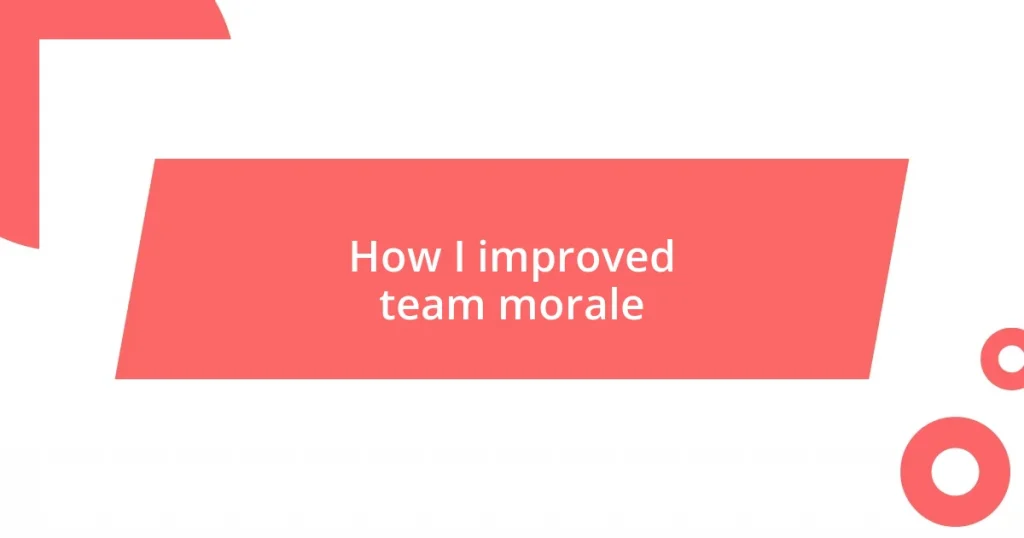Key takeaways:
- Building strong emotional bonds and fostering a sense of belonging through team-building activities significantly enhances team morale.
- Open communication and recognition of individual contributions are essential for boosting team spirit and fostering collaboration.
- Regularly measuring morale through check-ins and surveys helps identify areas for improvement and confirms the effectiveness of morale-boosting initiatives.
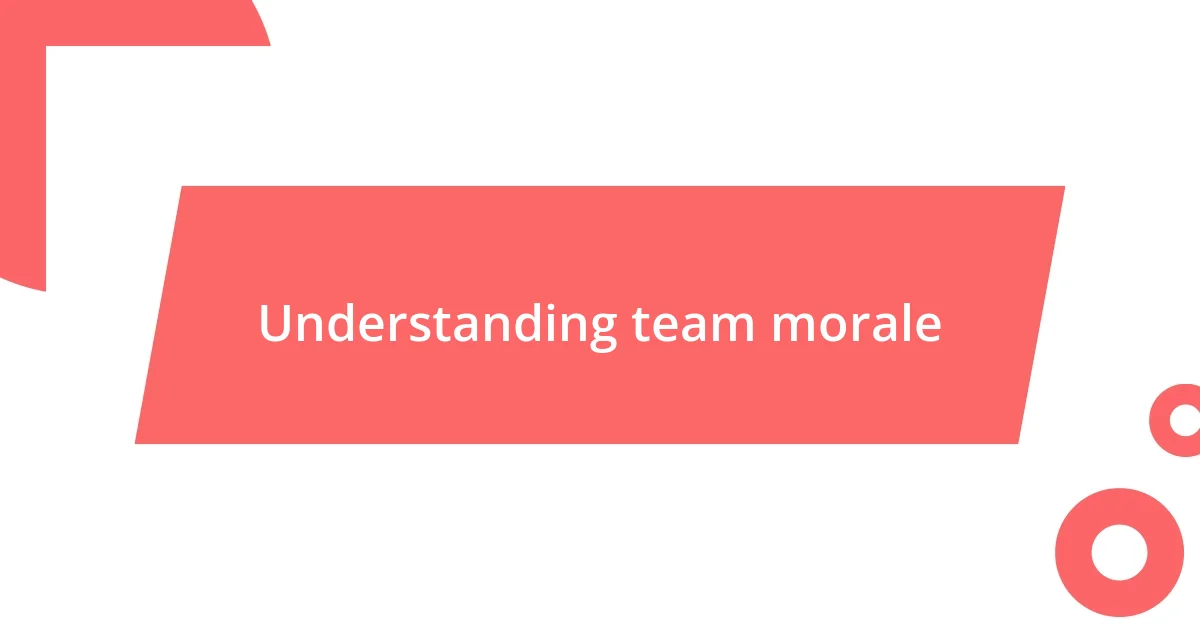
Understanding team morale
When I think about team morale, I often recall a time when I noticed the energy in my own team sink after a tough project. It wasn’t just the stress of the deadlines; it was the feeling of disconnect among us. I learned that morale isn’t just about work satisfaction; it’s deeply rooted in the emotional bonds we forge as a group.
Have you ever wondered why some teams seem to thrive, even under pressure? For me, it became clear that a strong sense of belonging and mutual support plays a huge role in boosting morale. I remember implementing team-building activities that allowed for genuine interactions outside of the usual work context. Suddenly, we were not just colleagues; we were a community.
It’s fascinating to consider how recognition can shift the atmosphere within a team. I once started a simple practice of acknowledging individual efforts publicly during meetings. The change was palpable. Seeing my teammates’ smiles reinforced that appreciation can be a powerful tool for enhancing team spirit and engagement, making me question how many leaders truly leverage this potential.
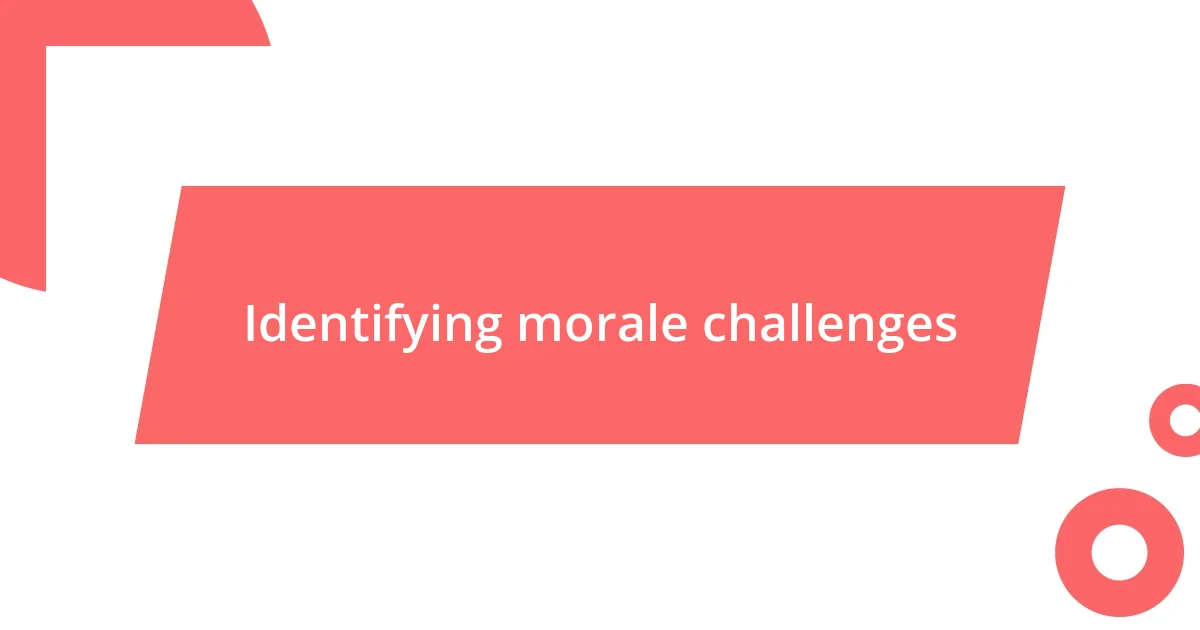
Identifying morale challenges
Identifying morale challenges often requires keen observation and active listening. There was a time when I noticed a few team members becoming withdrawn during team discussions. Their silence spoke volumes, revealing underlying feelings of frustration and disconnection. By paying attention to these subtle cues, I was able to pinpoint specific morale issues that needed to be addressed.
In another instance, I used anonymous surveys to gather honest feedback about team dynamics. The results were eye-opening; many expressed feelings of being undervalued or overwhelmed. I realized that creating a safe space for open dialogue was essential. This process not only identified morale challenges but also fostered a sense of empowerment among team members, making them feel heard.
A team’s energy can drastically shift with the tangibles that we often overlook—like workload balance and social environment. I learned this firsthand when I introduced flexible hours after noticing burnout symptoms within the team. The sense of relief and renewed enthusiasm was palpable. It made me reflect on how proactive approaches to identifying morale challenges can lead to happier, more engaged teams.
| Morale Challenge | Indicators |
|---|---|
| Withdrawal from Team Activities | Reduced participation in meetings and discussions |
| Negative Feedback on Feedback Surveys | Expressions of feeling undervalued or overwhelmed |
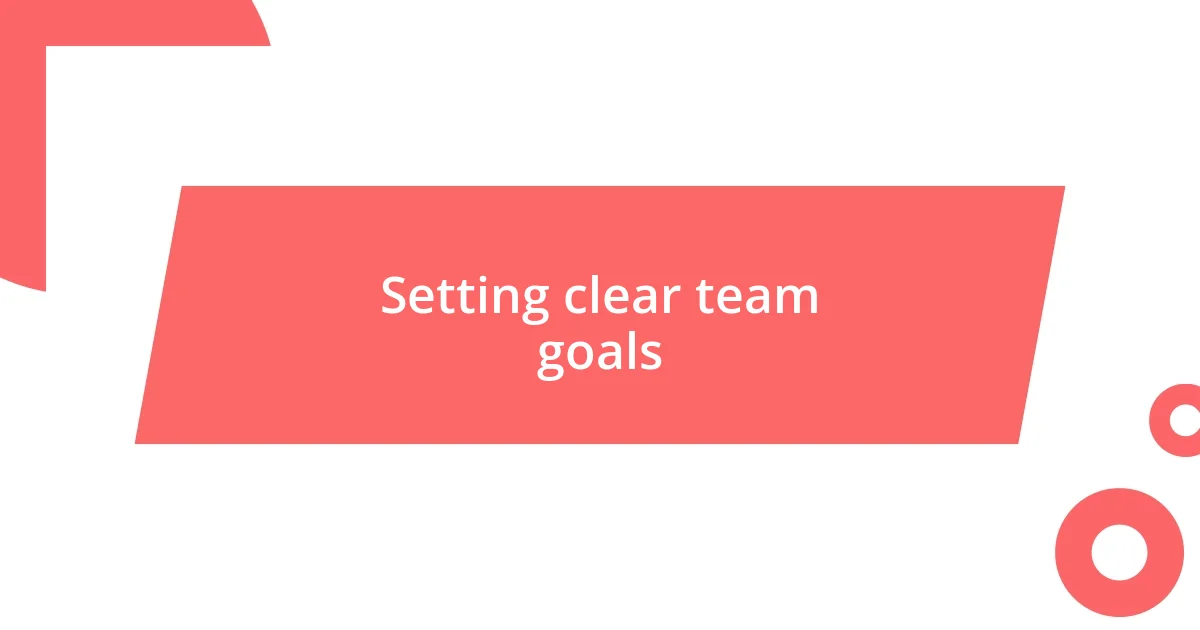
Setting clear team goals
When I decided to set clear team goals, I realized the importance of involving everyone in the process. I remember gathering the team for a brainstorming session, where each member was encouraged to share their ideas. This not only provided a sense of ownership but also cultivated excitement about our objectives. I could see the shift in their body language—their engagement level soared as we defined our targets together, which was a testament to the power of collaborative goal-setting.
To ensure that goals are not just lofty statements, I focused on making them SMART:
- Specific: Clearly define what we want to achieve.
- Measurable: Set criteria to track progress and success.
- Achievable: Ensure goals are realistic and attainable.
- Relevant: Align objectives with our team’s overall mission.
- Time-bound: Set a deadline to create urgency around accomplishing each goal.
Establishing these clear parameters transformed our approach. It felt like we were on the same journey, with everyone understanding their role in reaching our destination. The collective clarity had a noticeable impact on morale; team members felt motivated and ready to support one another in achieving what we set out to do. Sharing that experience made me realize just how crucial clear direction is for any team.
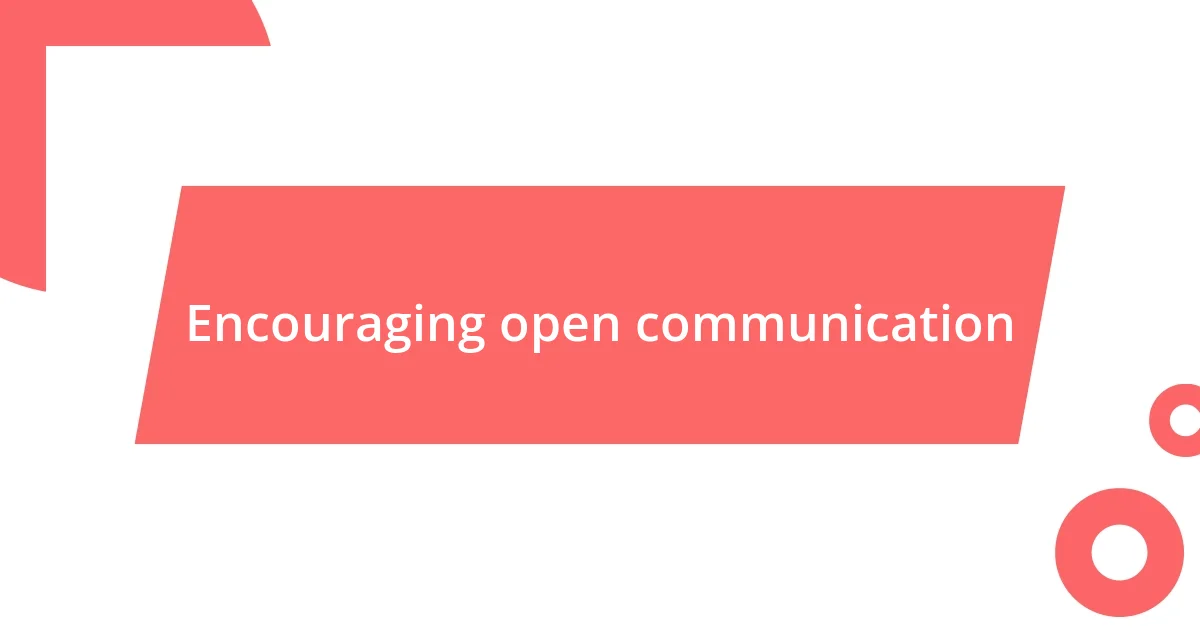
Encouraging open communication
One of the most transformative actions I took was fostering an environment where open communication was not just encouraged but celebrated. I vividly remember a team meeting where I invited everyone to voice their thoughts without fear of criticism. The nervous energy in the room quickly shifted to a sense of relief as each person shared their ideas and concerns. I could see the walls coming down, and the conversations flowed more freely than ever. Isn’t it amazing how a simple invitation to speak can unlock hidden insights?
To enhance this initiative, I introduced structured check-ins where team members could openly discuss their experiences weekly. These sessions weren’t just about project updates; they became a safe haven for sharing challenges and victories alike. I noticed that when people felt comfortable to express themselves, they often came up with creative solutions together. I remember a particular session where a team member suggested a new approach to an ongoing issue that not only resolved the problem but also strengthened our bond. It made me appreciate how powerful vulnerability can be in a team setting.
Listening intently is as important as speaking out. I learned early on that it’s not enough to encourage communication; I had to actively demonstrate it. By validating concerns and showing genuine interest, I saw an increase in trust and openness among team members. One day, a colleague shared their struggle with a project, something they hesitated to bring up before. After addressing it collaboratively, we found a solution and a deeper connection. How often do we let silence hinder meaningful exchanges? Emphasizing open communication not only bridges gaps but also cultivates a thriving team culture.
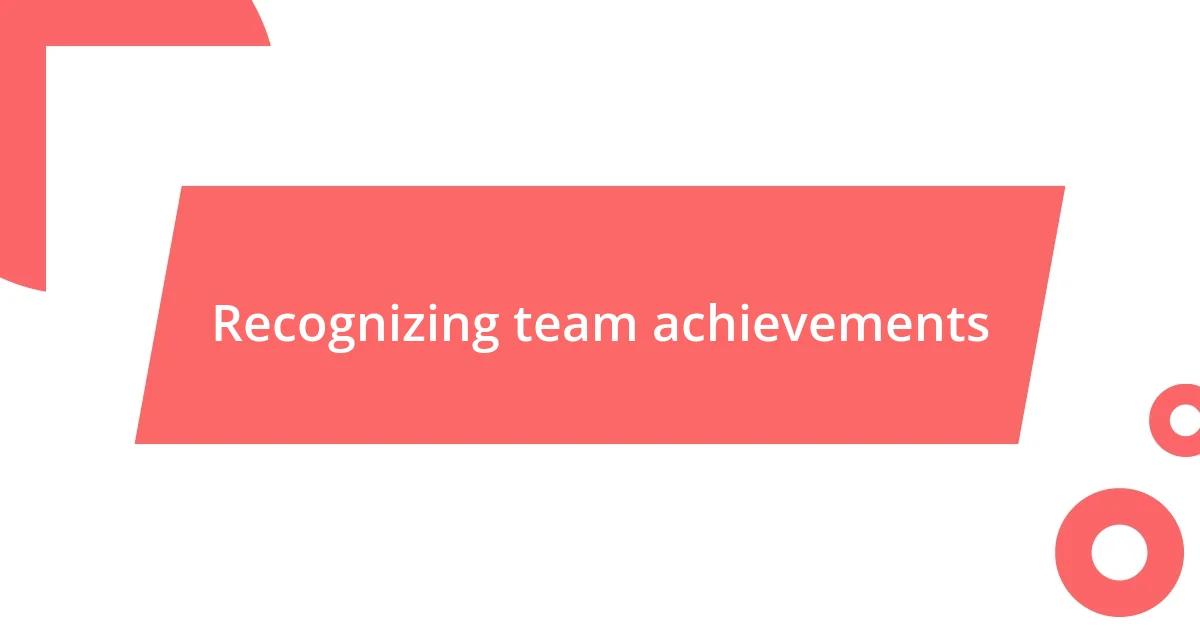
Recognizing team achievements
Recognizing achievements within a team is something I’ve found to be incredibly impactful. I remember a particular moment when we hit a key milestone. Instead of merely sending a quick email, I organized a small celebration to honor the team’s hard work. The smiles on their faces as we shared stories about the challenges faced along the way were priceless. It made me realize how such recognition not only boosted their spirits but also reinforced our unity as a team.
During another project, I started a ‘shout-out’ board where team members could highlight each other’s contributions. I was genuinely moved when one of the quieter members recognized the efforts of a colleague who often worked behind the scenes. It encouraged a ripple effect of appreciation. Isn’t it fascinating how acknowledging one person’s hard work can inspire others to do the same? When people feel valued, their motivation skyrockets, and I witnessed firsthand how a culture of recognition fosters more collaboration and goodwill.
I’ve also learned that it’s essential to recognize everyone, not just the loudest voices or most visible efforts. One day, I surprised our administrative assistant with a small thank-you note and a coffee gift card for keeping everything organized. While it may have seemed minor, the joy on her face was unmistakable. It reminded me that every role is vital, and when done consistently, this kind of recognition can elevate overall team morale and create a sense of belonging. What could be better than working in an environment where everyone knows their contributions matter?
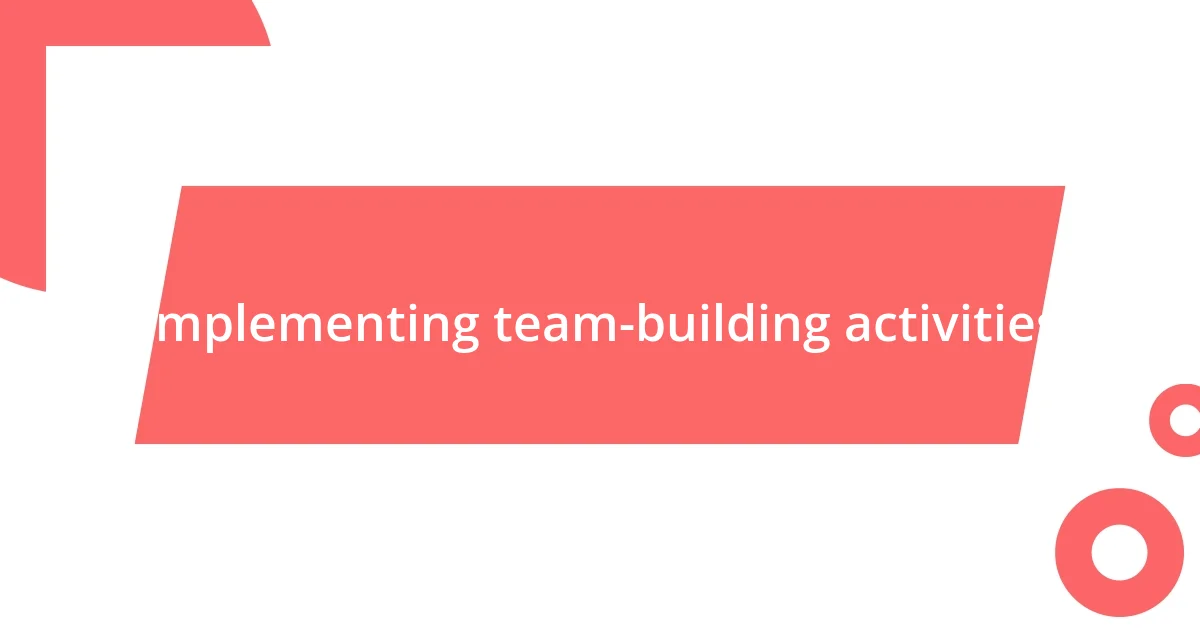
Implementing team-building activities
Implementing team-building activities has been a game-changer for us. I recall organizing a fun outing that combined team bonding with light-hearted competition. Watching my coworkers compete in friendly games was eye-opening; laughter echoed through the air, and I witnessed a level of camaraderie that often gets lost in day-to-day work. Can you believe how a little fun can truly transform relationships?
Another memorable initiative involved regular team-building workshops focused on creative problem-solving. I’ll never forget one session where we tackled a fictional crisis. The ideas that came from everyone as they collaborated were incredible. It felt rewarding to see people step out of their comfort zones, revealing skills and insights that we never knew existed. Isn’t it fascinating how working together on a fictional scenario can bring real-life challenges into clearer focus?
I’ve also realized that the best activities cater to diverse preferences. During one session, I incorporated an art-based team-building event, where each person expressed their vision for the team through painting. Not everyone felt comfortable with this format, but the powerful stories that emerged made it worthwhile. One team member shared how their piece represented overcoming obstacles, and it left a lasting impression on everyone present. How often do we overlook the power of creative expression in building a strong team?
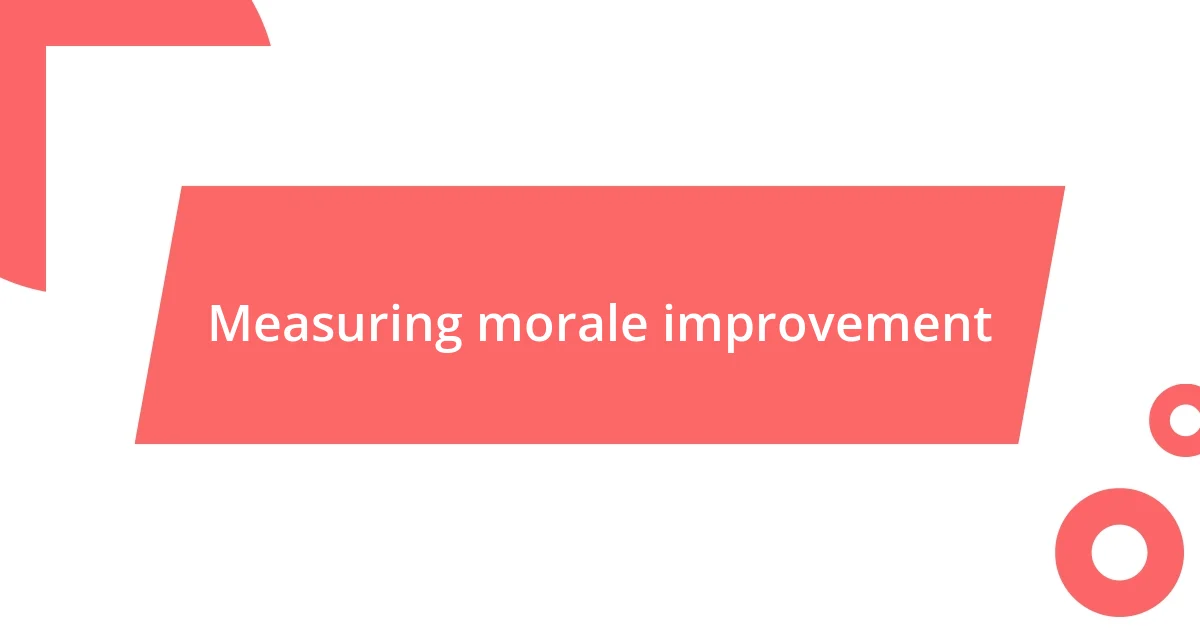
Measuring morale improvement
Tracking the improvement of team morale can be a bit like watching a plant grow; it requires a keen eye and regular care to see the changes. I’ve found that informal one-on-one check-ins with team members provide invaluable insight. During these chats, I often notice shifts in their energy and attitudes, which serve as telltale signs of morale ebbs and flows. Have you ever engaged someone casually and felt an instant change in their mood?
Surveys have also played a crucial role in quantifying this improvement. I remember conducting an anonymous pulse survey shortly after rolling out a new recognition program. It was uplifting to see an uptick in positive feedback regarding job satisfaction and team cohesion. The numbers matter, but it’s the stories behind them that breathe life into the data. Did a particular comment ever resonate with you, revealing the real impact of your actions?
Lastly, observing changes in collaboration and communication can be a strong indicator of boosted morale. In another instance, I noticed increased interactions during our brainstorming sessions. Team members were more willing to share ideas and build off one another. Seeing colleagues who previously shied away from discussions step forward not only warmed my heart but confirmed that our efforts to create a positive atmosphere were genuinely paying off. How often do we underestimate the power of a supportive environment in prompting meaningful dialogue?










